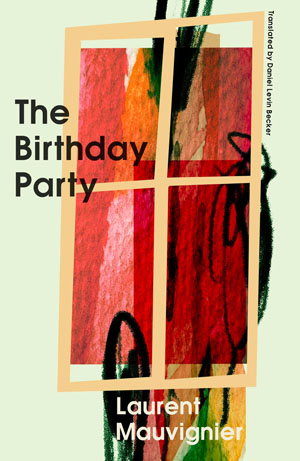The Birthday Party by Laurent Mauvignier
 Oakland, California. Transit Books. 2023. 444 pages.
Oakland, California. Transit Books. 2023. 444 pages.
Laurent Mauvignier’s 444-page-long novel is a painfully slow burn, and yet it provides for a most compulsive read. Mauvignier, the prolific French author of a dozen novels, has chosen a remote hamlet in the French provinces for the setting of his thriller, revisiting a setting of which French writers are quite fond. While Mathias Énard introduced the readers of his novel The Annual Banquet of the Gravediggers’ Guild to the quaint sides of country life, largely from the perspective of a young Parisian anthropologist striving to translate the mores of the provinces into a dissertation, Mauvignier’s humorous depiction of life in the French boonies does so entirely without the wink of the eye. Instead, he pulls out the gun of psychological scrutiny and puts four inhabitants of a small hamlet into the crosshairs of a relentless tour de force of narrative reckoning.
Mauvignier finds them in the geographical isolation of a few houses ominously called “Three Lone Girls”—a setting that slowly but surely will be revealed as a trap. Patrice Bergogne, an overweight and underappreciated farmer, tries to make a living off the little land he has inherited, lovingly devoted to his young daughter, Ida, and to his mystifyingly indifferent wife, Marion. With her fortieth birthday advancing, Marion for her part had never succeeded in reciprocating her husband’s patient advances and innumerable attempts at creating a marital life that may meet even the lowest of expectations.
The reader learns that Patrice’s sexual and emotional frustration are hardly a recent twist in the story of their marriage. From the beginning of their relationship, Patrice was painfully yet acceptingly aware of the mismatch between him, the bumbling peasant, and his much more mundane wife who returns from her office jobs late in the evening. In contrast to her meek husband, Marion is not one to accept any crap from her male colleagues and supervisors at work. Instead, she calls them out for their misogynist attitudes and pursues them with an unrelenting drive, to the admiration of her female colleagues with whom she likes to party after work.
Initially, the couple’s neighbor, an older painter who had left Paris to resettle in the quietude of the Three Lone Girls, appears to be the narrative’s target: Christine has been receiving threatening letters, which she reports, to little avail, to the police. The artist is close to the young child of their busy neighbors, friendly with Patrice, and heedful of withdrawn and inaccessible Marion, who remains a mystery to her just as much as to the readers.
With the pace, the persistence, and the sheer power of a cutterhead drilling a tunnel through the darkness of a mountain, Mauvignier penetrates the past and the present of his characters’ private lives and feelings. The slow motion of his narrative may at first annoy his readers who, several chapters into the novel, have become most intimately acquainted with a set of characters without being afforded even a hunch of what this all will lead up to. Only when the preparations for Marion’s fortieth birthday slowly but finally come into focus do they get a grasp of what’s to come.
Without increasing what students of cinema call the frames-per-second technique, Mauvignier has a new set of characters join the preparation for the celebration of Marion’s birthday. With the unexpected arrival of three violent young men, the readers feel almost relieved as the portentous mood that has been evoked in an almost suffocating manner gets lifted at last.
Of course, when the heavy clouds that have been hovering so low over the hamlet lift, it is not for the better. On the contrary. Following the meticulously prepared introduction of the setting and the characters, Mauvignier redirects the drill head of the novel to take aim at Marion’s life before entering this marriage of unequals. Her past catches up with her in the form of three violent brothers who are out to get her, to get even with her. Likewise, literary history appears to catch up with the author, whose innovative and powerful stylistics turn out to be spent in service of a tale that has been told so many times before: the tale of the girl who had fallen on hard times and who will not be able to outrun her dark past despite her best intentions.
To be sure, Mauvignier’s thriller is not a morality tale, though some of its thrill is owed to unveiling the woman’s vice while bringing the husband’s virtue to the fore. This psychological case study doesn’t end until the heroine recognizes that her failure to accept the love of her accommodating husband is rooted in her inability to understand that anyone could ever love her. Whether he, too, will have the time needed to act on this crucial insight is up to the readers to find out.
Thomas Nolden
Wellesley College































